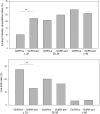GnRH agonist long protocol versus GnRH antagonist protocol for various aged patients with diminished ovarian reserve: A retrospective study
- PMID: 30403766
- PMCID: PMC6221355
- DOI: 10.1371/journal.pone.0207081
GnRH agonist long protocol versus GnRH antagonist protocol for various aged patients with diminished ovarian reserve: A retrospective study
Abstract
This retrospective analysis compared the efficiency of the gonadotropin- releasing hormone (GnRH) antagonist (GnRH-ant) protocol and the GnRH agonist long (GnRH-a) protocol for patients with diminished ovarian reserve (DOR). A total of 1,233 patients with DOR (anti-Mullerian hormone <1.1 ng/mL) were recruited for this retrospective case-control study. They were divided into two groups according to female age. Younger patients were assigned to POSEIDON group3 (PG3: age ≤35 years); older patients were assigned to POSEIDON group 4 (PG4: age >35 years). All patients with DOR underwent controlled ovarian stimulation and fresh embryo transfer (ET) on day 3. We recruited 283 GnRH-a and 54 GnRH-ant cycles for PG3, and 663 GnRH-a and 233 GnRH-ant cycles for PG4. In PG3, the GnRH-a protocol was associated with a lower ET cancellation rate (30/283 = 10.2% vs. 12/54 = 22.2%, p = 0.018) and a higher live birth rate (7/54 = 13.0% vs. 78/283 = 27.6%, p = 0.024) than the GnRH-ant protocol for the initiated cycles. Furthermore, the GnRH-a protocol was correlated with a higher implantation rate than the GnRH-ant protocol for ET cycles (146/577 = 25.3% vs. 11/103 = 10.7%, P = 0.027). No differences in the ET cancellation rate, live birth rate and implantation rate between GnRH-a and GnRH-ant groups were observed among PG4 patients. In conclusion, the GnRH-a protocol was more effective than the GnRH-ant protocol for young patients with DOR. The low ET cancellation rate and high implantation rate may be related to embryo quality or endometrial receptivity, which warrant further investigation.
Conflict of interest statement
The authors have declared that no competing interests exist.
Figures
References
-
- Biljan MM, Buckett WM, Dean N, Phillips SJ, Tan SL. The outcome of IVF-embryo transfer treatment in patients who develop three follicles or less. Hum Reprod. 2000;15(10):2140–4. Epub 2000/09/28. . - PubMed
Publication types
MeSH terms
Substances
LinkOut - more resources
Full Text Sources
Medical


